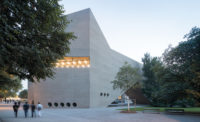Beijing
Completed last spring at the northeast corner of Tiananmen Square, the world's biggest museum stands up to the enormity of Beijing's central public space. But the new National Museum of China also points in not so subtle ways to the growing pains of a nation that's striving to become a cultural, as well as economic, powerhouse.
To create the museum, the German firm Architekten von Gerkan, Marg und Partner (GMP) performed a gut renovation of an earlier, historically significant building. Facing the Great Hall of the People across Tiananmen Square, the original Sino-Socialist structure was erected in 1959 as one of Mao's 'Ten Great Buildings,' commemorating the tenth anniversary of the People's Republic. It was designed by the late Zhang Kaiji (father of well-known architect and MIT professor Yung Ho Chang), and previously housed two institutions: the Museum of Chinese History and the Museum of the Chinese Revolution.
The brief called for a single museum that would preserve most of the existing building's granite exterior, with its imposing colonnades and golden-tiled cornices. It also mandated an extension that nearly tripled its size, from 700,000 square feet to 2 million.
To do so without significantly expanding its footprint, GMP replaced an existing central core with an 850-foot-long 'Grand Forum' spanning the building's length to connect the north and south entrances with the western, Tiananmen-facing one. Maintaining the original structure's rigid symmetry, monumental staircases flanking the main entrance now lead up to the Modern Galleries (essentially, the former Museum of the Chinese Revolution) to the north, and an administrative and library wing to the south. Three stacks of rectangular galleries devoted to temporary exhibitions form a new central core.
The Ancient Galleries (formerly the Museum of Chinese History) occupy the 396,000-square-foot basement level, alongside two theaters, a television studio, research areas, and parking. Below this, a sub-basement houses the museum's 200,000-object collection that's not on public view. (It's this storage area that makes the museum the world's biggest; by exhibition space, the Louvre and the Hermitage are larger.)
GMP's initial proposal, which was chosen over Herzog & de Meuron's, OMA's, and Foster + Partners', among others, included a curving 'flying roof' over the Ancient Galleries, dramatically juxtaposing old and new construction. But 'the client wanted something that was in harmony with the old building,' GMP partner Stefan Sch'tz explains. 'They wanted to treat the building with respect, and we understood this.'
The roof was tamed, while the extension's new facade'separated from the 1959 entrance by a long, outdoor courtyard'was given slender pillars topped by modernized takes on traditional douggang brackets. Massive perforated bronze doors and coffered ceilings also reference historic Chinese architecture.
Echoing the void of Tiananmen Square, the more significant nod to contextualism may be the Grand Forum'or, rather, the sheer scale of its emptiness. Though GMP designed it to accommodate art installations, they have yet to be realized. The Forum remains a mostly featureless space, save for its stairs, escalators, granite and cherrywood cladding, and a massive, bas-relief Socialist-Realist-style mural. You might as well be in a hotel conference center.
What's more, the scheme gives pride of place to the temporary exhibition spaces, in the new central core. Yet from the Forum, you can't see what's on display there, and even if you could, you might be disappointed. The inaugural show about art of the German Enlightenment will have been up for a year before it closes. Other exhibitions have promoted Louis Vuitton luggage and Bulgari jewelry. (The museum has been criticized for glossing over the less glorious moments of Communist rule in its permanent exhibitions.) GMP did an admirable job combining old and new. But like many museums in China, this one has a programming infrastructure that lags behind its architectural ambition, and neither seems to have been planned with the other in mind. With its rich history and fertile contemporary art scene, China is anything but a cultural vacuum. For now, it's difficult to say the same of the country's museums.
Beijing Design Week.
Location: Beijing
Completion Date: April 2010
Gross square footage: 2 million square feet
Cost: $380 million
People
Owner:
Architect:
Personnel in architect's firm who should receive special credit: All people are registered architects Interior designer: gmp Architects
Engineer(s): Electrical engineering: CABR
Consultant(s): Lighting: conceptlicht GmbH/Traunreut, TsingHua Design Institute/Beijing Acoustical: Müller-BBM Group and ADA Acoustic Design Ahnert Photographer(s): Christian Gahl Renderer(s): gmp Architects |
Products
Structural system Interior: Light Chinese granite stone, black cherry panelling, sparkling and bronze-coloured aluminium cladding, patinated bronze, red fabric
Exterior cladding Bronze cladding: Jinxing Bronze World Ornament Material
Lighting |









Post a comment to this article
Report Abusive Comment